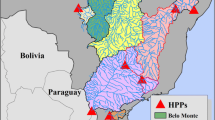Abstract
The Piracicaba river basin is a subtropical watershed located in the southeastern region of Brazil. With an area of 12 400 km2, the basin is a typical example of new landscape resulting from development in tropical and sub-tropical regions: establishment of intensive industrial and agricultural processes were followed by significant population growth and water management. This scenario has led to significant increase in water demand and decrease in water quality. The main objective of this study is the detection of changes in the patterns of flow and precipitation in the basin, and its possible relation to man-induced changes. Statistical analyses were performed on records of precipitation, evapotranspiration and streamflow, from 1947 to 1991. Precipitation and evapotranspiration totals showed significant increasing trends for the entire basin. From eight streamflow gauge stations, half showed significant decreasing trend. The most probable cause of such trends is the export of water from the basin to the metropolitan region of São Paulo city.
Similar content being viewed by others
References
BAHC: 1993, Biospheric aspects of the hydrological cycle: The operational plan, BAHC Report No. 27.
Cavadias, G. S.: 1992, A survey of current approaches to modeling of hydrological time-series with respect to climate variability and change, Report WCASP-23, World Meteorological Organization/TD-No. 534.
Caron, D., Pinazza, A. H. and Scampini, P. J.: 1993, A agropecuária na bacia do Piracicaba (1960- 1992), Relatório Técnico CENA/USP (in Portuguese).
CIBRPC - Consórcio intermunicipal das bacias dos rios Piracicaba e Capivari: 1992, Plano diretor de captação e produção de água para abastecimento público nas bacias dos rios Piracicaba e Capivari, Jaakko Poyry Engenharia Ltda (in Portuguese).
DAEE - Departamento de Águas e Energia Elétrica: 1985, Estudo de águas subterrâneas - Região administrativa 5 Campinas. Ed. Governo do Estado de São Paulo (in Portuguese).
Demarée, G. R.: 1990, An indication of climatic change as seen from the rainfall data of a Mauritanian station, Theor. Appl. Climatol. 42, pp. 139–147.
Demarée, G. R. and Nicolis, C.: 1990, Onset of Sahelian drought viewed as a fluctuation induced transition, Quart. J. Roy. Meteor. Soc. 116, pp. 221–238.
Dunne, T. and Leopold, L. B.: 1978, Water in Environmental Planning, W.H. Freeman and Company, San Francisco.
Goossens, C. and Berger, A.: 1986, Annual and seasonal climatic variations over the northern hemisphere and Europe during the last century, Annales Geophysicae 4(B4), 385–400.
Ometto, J. C.: 1989, Registros e estimativas dos parâmetros meteorológicos da região de Piracicaba, S.P. Ed. Fealq (in Portuguese).
Pettitt, A. N.: 1979, A non-parametric approach to the change-point problem, Appl. Statist. 28(2), 126–135.
Sabesp: 1989, Data Oper - Sistema Cantareira. Ed. Governo do Estado de São Paulo (in Portuguese).
São Paulo: 1990, Plano Estadual de Recursos Hidricos - Conselho Estadual de Recursos Hídricos. Ed. Governo do Estado de São Paulo (in Portuguese).
Schadler, B.: 1987, Long Water Balance Time Series in the Upper Basins of Four Important Rivers in Europe - Indicators for Climatic Changes? in Proceedings of the Vancouver Symposium, on the Influence of Climatic Change and Climatic Variability on the Hydrologic Regime and Water Resources, IAHS Publ. 168.
Sneyers, R., Vandiepenbeeck, M., Vanlierde, R. and Demaree, G. R.: 1989, Climatic changes in Belgium as appearing from the homogenized series of observations made in Brussels - Uccle (1833-1988) Presented at the Symposium: Climatic Change 22-26 June, Brno, Czechoslovakia.
Sneyers, R.: 1975, Sur l'analyse statistique des séries d'observations, Note Technique No. 143, OMM - No. 415, Genève, 192 p.
Turner, B. L., II, Meyer, W. B. and Skole, D. L.: 1994, Global land-use/land-cover: Towards an integrated study, Ambio, Vol. 23, No.1, pp. 91–95.
Turner, B. L., II, Moss, R. H. and Skole, D. L.: 1993, Relating land use and global land-cover change: A proposal for an IGBP-HDP core project, IGBP Report No. 24, HDP Report No. 5.
Vitousek, P. M., Ehrlich, P. R, Ehrlich, A. H. and Matson, P. A.: 1986, Human appropriation of the products of Photosynthesis, Bioscience 36, 368–373.
Wei, T. C. and McGuinness, J. L.: 1973, Reciprocal distance squared method. A computer technique for estimating areal precipitation, Agricultural Research Service, U.S. Department of Agriculture, Report ARS-NC-8.
Author information
Authors and Affiliations
Rights and permissions
About this article
Cite this article
Moraes, J.M., Pellegrino, G.Q., Ballester, M.V. et al. Trends in Hydrological Parameters of a Southern Brazilian Watershed and its Relation to Human Induced Changes. Water Resources Management 12, 295–311 (1998). https://doi.org/10.1023/A:1008048212420
Issue Date:
DOI: https://doi.org/10.1023/A:1008048212420




